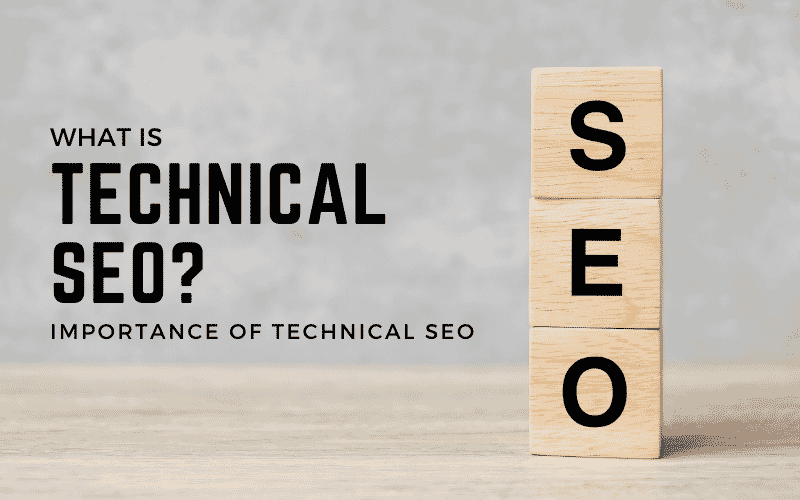Given the complexity of website design and operation, you must do everything you can to make yours as quick, effective, and user-friendly as possible. Technical search engine optimization (SEO) is one of these factors since it focuses on the foundation of your website and how it interacts with search engines. You must know the importance of technical SEO whether you are tech-savvy or not.
For search engines to properly index and rank your site, it must be clear of any technical flaws that could impede users from quickly navigating it. It would help if you employed technical SEO strategies to increase your organic traffic and sales.
Whether you are a small-medium or large-scale business or your business falls into the automobile industry, real estate industry, cryptocurrency investment, digital marketing, or anything else, your business website must need technical SEO to rank higher on the search engine.
Contents
Technical SEO:

The goal of technical search engine optimization (SEO) is to make your website more easily crawled and indexed by search engines like Google. Sitemaps, page speed, URL structure, schema, site navigation, and other technical aspects of your website are addressed.
Site design and content are useless if consumers can’t access or browse your site, so technically optimizing your website is crucial if you want to attract organic traffic from search engines.
The Importance of Technical SEO:
A well-built website loads visitors quickly and is easy for search engine spiders to navigate. When a site is technically set up correctly, search engines can better decipher its purpose, and issues like the same material are less likely to throw them off.
Furthermore, it does not lead users or search engines down dead ends due to broken links. In this article, we’ll quickly cover the basics of what makes a website technically sound.
1. It’s Fast:
Users nowadays expect web pages to load quickly. People are impatient, and they dislike having to wait for a page to load. According to research from 2016, 53% of mobile site visitors will quit a site if it does not load within three seconds. If your website takes an unreasonable amount of time to load, people will leave and go elsewhere.
Google is well aware of the negative impact of slow-loading web pages on users. As a result, they choose websites that are quick to load. As a result, a slow web page receives even fewer visitors than its faster equivalent because it ranks lower in search results. In 2021, the speed with which a user sees a web page load will be considered a ranking criterion.
2. Crawlable for Search Engines:
Sites are “crawled” by robots used by search engines. Robots use the link following to crawl your site for relevant material. They can tell what is most crucial to them by how your site is linked together.
However, robots can be directed in other ways as well. If you don’t want them to access a specific page on your site, you can prevent the crawlers from accessing it. You can even allow them to crawl a page while telling them not to include it in search results or ignore any links it contains.
3. Robot.txt
The robots.txt file permits you to tell web crawlers where on your site they should go and what they should avoid. It’s a potent weapon that requires careful use. We warned at the outset that it only takes a single typo to prohibit spiders from accessing vital sections of your site.
Inadvertently blocking CSS and JS files in the robots.txt file is a common mistake. These files contain the code that conveys to browsers the structure and functionality of your site. If you prevent search engines from accessing specific files, they cannot determine if your site is functional.
4. No dead links:
As we’ve established, user patience is quickly worn thin when dealing with sluggish websites. Visitors may find it much more frustrating than waiting for a delayed page to load if it simply doesn’t exist. The 404 Not Found page will be shown if a user tries to access a nonexistent page via a link. Your well-planned user experience has just been destroyed.
Also, search engines don’t like to come across these problem sites. Since they click on every link they come across, no matter how obscure, they locate even more dead links than visitors.
Since a website constantly evolves (people add and remove content), certain links may no longer work. There are software tools available to assist you in reviving dormant relationships. You learn more about your resources and how to deal with 404 problems by reading on.
When a page is deleted or relocated, the URL should be redirected to avoid broken links. It is preferable to send visitors to a new page that will eventually replace the old one. Make your redirects with ease with Yoast SEO Premium. You won’t even need a programmer!
5. It prevents search engines from being confused by duplicate content:
If the same material appears on many pages of your website – or even on different websites – search engines may become confused. Because if these pages provide identical content, which should rank highest? Consequently, they may rank all pages with the same information lower.
Unfortunately, you may be suffering from duplicate material without even realizing it. Due to technological considerations, various URLs may display identical material. This makes no difference for a visitor, but it does for a search engine, which will view the same material at a different URL.
This problem has a technical answer, thankfully. Using the so-called canonical link element, you may specify your website’s original page – or The page on which you wish to achieve a high ranking in search engines – Yoast SEO allows you to set a page’s canonical URL. And for your convenience, Yoast SEO inserts self-referencing canonical links to every page. This will prevent issues with duplicate content that you may not even be aware of.
6. It’s Secure:
A safe and secure website is technically optimized. Providing users with a secure website that protects their privacy is a fundamental need. You may take several steps to safeguard your (WordPress) site, but adding HTTPS is one of the most important.
HTTPS ensures that no one can intercept information exchanged between a browser and a website. Therefore, if users log in to your website, their credentials are secure. You’ll need a so-called SSL certificate to enable HTTPS on your website. Google recognizes the significance of security and has consequently made HTTPS a ranking signal: secure websites rank higher than their insecure counterparts.
In most online browsers, it is simple to determine whether or not your website utilizes HTTPS. To the left of the search bar box in a web browser, a lock will appear if the site is secure. If “not secure” appears, you (or your developer) have some work to do!
7. It has Structured Data:
Thanks to structured data, search engines may learn more about your website, content, and business. Using structured data, you can inform search engines about the types of products you sell or the recipes you offer. As a bonus, you’ll get to go into extensive depth on the features and benefits of those products or recipes.
Search engines quickly discover and understand this information since it is provided in a standard format (specified on Schema.org). It helps in giving context to your information. You may learn more about how Yoast SEO can assist you and how it operates by reading the story provided here. Yoast SEO, to give just one example, generates a Schema graph and provides free structured data content blocks for your FAQ and How-To pages.
There are benefits to using structured data beyond merely helping search engines better understand your content. It also qualifies your content for rich results, which are the highlighted ones with stars or more information.
8. XML Sitemap:
An XML sitemap is a simple index of all the pages on your site. It’s a road plan that helps search engines find their way across your site. Simply put, it guarantees that search engines will crawl all of your site’s content, including the parts you care about the most. Pages, posts, tags, and other custom post kinds are familiar places for XML sitemap categorization, and it’s also common for the sitemap to list the number of photos and the date each page was last edited.
If possible, an XML sitemap shouldn’t be used for a website. If it has a well-organized system of internal links, crawlers won’t need it. However, not all websites have stellar architecture; therefore, it certainly doesn’t hurt to include an XML sitemap. Consequently, it would help if you always had an XML site map available to your visitors.
9. Using Hreflang:
Search engines need guidance in determining which nations or languages your site is intended for if it targets more than one. With your cooperation, they can tailor search engine results to each user’s geographic location.
A tool called Hreflang tags can assist you in doing that same thing. If you want a page to be displayed in a specific language and country, you can specify such settings. If your US and UK sites say identical material, Google will understand that it was written for a different location.
Optimizing web pages for several languages is a niche industry. We recommend checking out our Multilingual SEO training if you want to learn how to improve the search engine rankings of your multinational sites.
Also, Read
Top 5 PDF Splitter Tools for Digital Marketers
How to Create New Layer From Selection in Gimp
Advantages And Disadvantages of HTML You Should Know
eCommerce Facebook Ads Funnel | A Comprehensive Guide!
WordPress Page Not Found After Publish? Easy Fix
Webpage Is Currently Unable To Handle This Request. HTTP error 500 Fix
